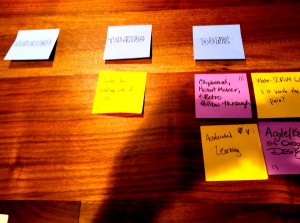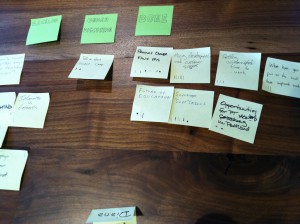Preserving culture during company growth
– You can’t preserve culture. It is made every day.
– If you want a certain culture, do those things.
– Choose people when hiring
– Office can set the tone
– Management can set priorities but they need to do them.
– Do you want the same culture after growth? Cultures don’t necessarily scale. Culture of 30 doesn’t work with 80.
– New people will change the culture. You can’t avoid it; you can try to steer it.
– Politics
Help desk knowledge base / beta software
– Multiple products
– new refs on different schedules
– how to support beta customers
– beta customers may not know that they are beta customers. (more of an A/B sort of testing)
– who gets the beta?
– stop doing beta. Deliver faster, do fewer changes in each release.
– Dogfood
Managing customer-visible help pages
– Standard pages vs custom pages written by a rep
– Can customer tell what they are looking at?
– How would you find errors?
– Variation by itself isn’t a problem; incorrectness is.
– customer-facing sites may become stale
– CSRs need to be accountable for accuracy
– Do pages get audited?
– What about when CSRs move on>
Bringing standup back to focus
– Gamify it
– Time people
– encourage brevity: measure it.
– try it for a week and people will start to recalibrate to what a short statement sounds like
– What is the point of the standup? (varies by team)
– Limit who is in the meeting. Only pigs get to talk; chickens get to watch. (In consulting, being a pig or a chicken depends on if you are billable to that project)
– Stay on target
– If what you want to say doesn’t add value, don’t say it.
– Learning questions: Instead of talking about what you did, talk about what you learned.
– Be aggressive about the rathole call: if the discussion is wandering, call people on it.
– For special cases: you can talk as long as you hold the electric ball: http://www.thinkgeek.com/product/91b8/
– Don’t have the standup in a comfortable place where people relax. Stand up; make people want to finish and get back to work.
– Save the staff meeting stuff for a staff meeting
How to companies manage customer experience across different channels (blog, ads, help desk, youtube videos, etc)
– Who owns each channel?
– Does old content get pruned?
– Analyze what works
– Who originates content? (NR has engineers write blog postings about new features)
– Solutions can get out of date
Presenting to developers
– Know your audience
– Know your material
– Know your message
– Right amount of emotion in your talk. Engineers can smell a sales pitch and will tune you out
– More interactive/less interactive
– Tell a story. Don’t just recite facts.
– Talk about the “why”
– Get devs talking to customers, out of their comfort zone
– Presentation Zen/Tufte
– Interactivity
– are you trying to influence behavior or just convey information?
Lean Roadmaps
– Once you get past a few months out it gets fuzzy
– Quarterly roadmaps
– features vs maintenance
– Release often and change direction as needed
– All about communication
– still need a vision, even though the specifics may be fuzzy
– 3 months is a long time in technology
– Always question priorities. Are we doing the most important thing?




